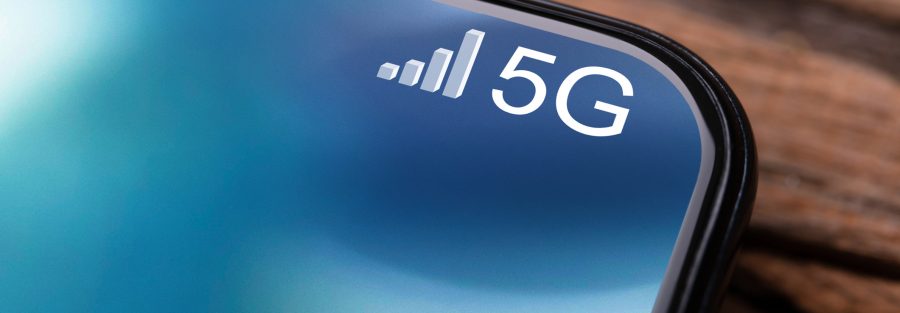Ready for 5G?
Each year, the predictions of new technology and what the year may hold are on everyone’s mind, and curiosity about 5G is no exception. Looking back at 2020, there have been significant milestones in the buildout and integration of 5G networks; however, the progress still varies based on carrier. Let’s take a closer look into what transpired with 5G in 2020 and what we can look forward to in 2021.
Milestones
5G cellular technology is being integrated into the public rapidly – particularly when compared to the growth of 4G LTE, its predecessor. As of December 2020, there were 143 commercial 5G networks across the globe, 303 commercially available 5G devices, and 225 million total 5G subscriptions. These milestones make it the “fastest growing mobile technology in history,” according to the research of industry group 5G Americas.
Each carrier had their own successes with the growth of 5G in 2020.
- In July, AT&T became the second carrier to launch a nationwide 5G service (after T-Mobile in late 2019), with significantly faster network speeds and performance than T-Mobile offered at the time.
- T-Mobile announced in December 2020 with the launch of their mobile hotspot plans that their Extended Range 5G network covered over 250 million people in 1.4 million square miles.
- In October, Verizon earned several rewards for its 5G service from the Opensignal US 5G User Experience Report. The report focused on three key categories: 5G Download Speed, User Download Speed Experience, and 5G Availability. In addition to providing the fastest average 5G download speeds, Verizon’s 5G network also earned best Download Speed Experience.
By the end of 2020, each carrier had major growth in their 5G networks. Consumers and businesses are eagerly waiting for 5G to become a reality, but there is still much work for the networks and coverage to expand. Looking ahead, there are already announcements for network growth and expansion from the nation’s carriers this year.
Industry Landscape
Looking at the current landscape of major carriers in the United States, the progress of 5G integration is somewhat similar, but varies from company to company. Let’s take a look at a breakdown of where each carrier stands at the beginning of a new year.
Verizon is currently offering several 5G options, which will become increasingly available in the next year. Verizon’s coverage of 5G is also expected to nearly double in 2021.
- Verizon’s two current varieties of 5G are “Ultra-Wideband” and “Nationwide”.
- Their faster 5G service is “Ultra-Wideband” (also referred to as millimeter wave or mmWave). This service is currently available only in certain parts of certain cities. Ultra-Wideband coverage is reported to be far better than what most consumers are accustomed to.
- “Nationwide” is a low-band variety and is slower than mmWave, but it offers much broader coverage than its Ultra-Wideband counterpart. However, Nationwide 5G can still occasionally be even slower than 4G! If your phone is experiencing slowdowns on 5G, experts currently suggest switching off 5G in favor of 4G LTE service.
AT&T is also currently providing two types of 5G coverage: standard 5G and a faster mmWave service.
- AT&T has invested in a mmWave version called “5G Plus,” but only in limited places.
- There are currently no coverage maps available for 5G Plus – AT&T says that it is deployed in “select innovation zones” in parts of certain cities.
- If you’re in one of those lucky “innovation zones”, then prepare for high-speed downloads and cellular data use!
- The standard coverage AT&T offers is slower than 5G Plus, but more widespread, similar to what other carriers offer.
Like Verizon and AT&T, T-Mobile offers both high and low-band frequencies for 5G. T-Mobile is also working on converting Sprint’s former mid-band frequencies to 5G.
- This may not be as fast as the mmWave competition, but it is predicted to be significantly faster than 4G.
Costs:
Still wondering how much it will cost for you to use a 5G phone with a 5G plan?
Similar to 4G LTE coverage, the pricing and availability of 5G service will vary greatly from carrier to carrier, particularly with regard to geography; investment from carriers has been primarily in specific urban areas.
Verizon’s Shared Data (data capped) plans and its $80-per-month basic unlimited plan include the lower-tier Nationwide 5G only. For access to UW in addition to Nationwide 5G, consumers will need at least the $90 “Play More” unlimited plan.
Both 5G and 5G Plus are included in all AT&T’s postpaid unlimited plans, which start at $75 per month ($65 with auto pay). The Unlimited Plus prepaid plan also includes it at $75 per month ($60 with auto pay).
All of T-Mobile’s postpaid plans include 5G, starting with the $65 per month ($60 with autopay) Essentials plan. One potential drawback to the Essentials plan is that customers on that base-level plan are the first ones to experience slowdowns when the network is congested. T-Mobile does not offer 5G on its prepaid plans.
For the most affordable access to mmWave technology, users on AT&T’s unlimited plans are positioned well in the start of 2021.
Verizon announced the expansion of its 5G Home broadband offering to six new cities – Arlington, TX; Miami, FL; San Francisco and Anaheim, CA; and St. Louis, MO on Jan. 14., followed by Phoenix, AZ shortly thereafter.
T-Mobile is looking to broaden its offerings in 2021 with a unique angle – the first-ever available 5G MiFi Hotspot. To coincide with the new hotspot, T-Mobile is also adding a new “limited time” hotspot plan that will offer 100GB of high-speed data for $50 per month. The carrier advertises that a rival $50 plan from Verizon only gets 5GB per month of hotspot data, while AT&T’s similarly priced hotspot offering only has 15GB per month.
Regardless of which carrier you prefer, 5G is starting to be integrated into our lives in 2021.
Future of Business and 5G:
As 5G begins to be more widely adapted, businesses will be able to leverage wireless networks in ways that were not previously possible. This will help small-to-midsized businesses in particular to compete against larger competitors on a more level playing field.
In addition to improved speed and capacity, the biggest impact that 5G could have on corporate enterprises is the ability to work within the Internet of Things (IoT). In a world filled with sensors, smart appliances, smart cars, and more, the ability to understand and work within the network of IoT devices will launch those forward-thinking businesses far ahead of competitors who do not capitalize on the new technology.
For example, 5G can enable financial institutions to extend their reach by providing a complete branch experience at temporary locations like music festivals, sporting events, college campuses, and disaster-affected areas. The speed and responsiveness of 5G could enable simultaneous wireless functionality of ATM and other self-service kiosks, employee telepresence, teller systems, WiFi, video surveillance, and more.
Early 2021
At CES 2021, the new year was kicked off with discussions surrounding 5G and its future uses and applications. At this year’s show, Motorola announced the Motorola One 5G Ace at $400 and China’s TCL announced the TCL 20 5G. These device debuts were significant because most of the 5G phones released up until this point have been expensive, often over $700 and occasionally over $1,000. Neither newly-announced phone supports the mmWave version of 5G, but that’s to be anticipated at these lower price points.
In addition to new 5G phones, Laptop PCs are beginning to see growth in the 5G space. Just prior to this year’s CES, Dell launched several new PCs – these include the latest Latitude 9420 and 9520, both of which offer options for 5G modems that support both sub-6 and mmWave-based 5G. Additionally, HP announced the latest version of its DragonFly Elite notebook, which is among its first to support a 5G modem.
In addition to traditional devices like phones, tablets and laptops, several automakers and OEM suppliers announced 5G tech at CES 2021. Harman and its parent company, Samsung, debuted concept cars that featured integrated 5G connectivity for in-vehicle entertainment systems, as well as the potential for future vehicle-to-vehicle communications as 5G continues its rapid growth.
Looking Ahead
Whether you’re a tech-savvy early adapter or are just learning about 5G, in the year to come, 5G is sure to become a more prominent fixture in your life. With Apple releasing the new iPhone 12 with 5G capabilities last September, the latter part of 2020 became the turning point where there was a significant amount of 5G hardware available.
The upcoming spring refresh cycle will present a robust future for 5G as nearly every new device launched in 2021 will have 5G. If you have a device on a network with a major carrier, you may begin experiencing 5G sooner than later in parts of major cities. While 5G is on the cusp of becoming mainstream, factors which still exist that may speed 5G saturation include lower equipment price points by manufacturers, expanded network coverage by the carriers along with positive consumer confidence.
Keep an eye out over the next year for the top corner of your phone, and you may just see the 5G symbol appear when you least expect it.



